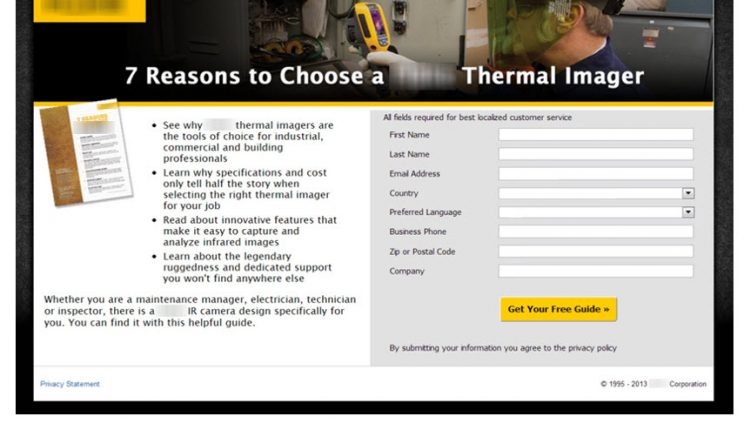Lead Generation: How one company increased leads 96% by changing the presentation of incentive content
A common way to gain lead information is by offering free content, such as a white paper or guide.
But if it’s free, why don’t we have 100% lead capture rates?
Why do prospects provide their information for one PDF guide, but not for another?
The answer may not be in the incentive itself, but rather, in how you’re presenting it.
Last week, I had the pleasure of joining Jon Powell, Senior Manager, Research and Strategy, MECLABS, on the MarketingExperiments monthly Web clinic, “Leveraging Content to Generate Leads: 3 simple tactics one company used to generate a 96% increase in leads.”
We discussed an interesting case study where one B2B company generated a 96% increase in leads by simply altering how a piece of content was presented to its customers.
Today, we’ll review the highlights of that experiment.
Background: A B2B company selling thermal image cameras.
Goal: To generate more leads.
Research Question: Which landing page will generate the most leads?
Test Design: A/B variable cluster, radical redesign split test
Control
Our researchers hypothesized an uneven value exchange existed on the control and prevented a higher form completion rate. The page asked for more cost (form fields) than it provided in value.
The headline and copy contained company-centric messaging rather than focusing on the benefits visitors would receive.
Treatment
With the treatment, the team wanted to increase the value exchange by clarifying the value of the current offer, as well as reduce friction.
To lower the cost portion of the value exchange, the number of form fields was reduced. To increase value, the headline and page copy focused on customer benefits. Value was added in the instructions of the form as well. The image also more effectively showed the product in use.
Results
Clickthrough to submit the form increased 95.8% with a 99% level of confidence.
What you need to understand
To say “yes” to an action, customers need to see a positive value exchange. If the perceived cost of an action is more than the perceived value, visitors will not take the action we want them to.
The value exchange in the control was low:
Multiple factors weighed down our cost force, and we didn’t have as much value infused on the page as possible.
In the treatment, we pumped up the value while decreasing the mental cost visitors experienced:
As you can see with this case study, even free content comes with a cost.
Even if the visitor could download without filling out a form, it would still take their time and energy to click the button, wait for the file to download and open it.
You must remember that for every action you ask the customer to take – whether that’s to open an email or purchase an item – the customer performs a mental, often subconscious, operation: Is the value equal to or greater than the cost?
You may also like
Web Optimization Summit Sessions [Interested in more conversion optimization strategies? View 16 free on-demand sessions from Web Opt Summit 2014]
Lead Generation: Perceived value and cost of free incentives [Live test from Lead Gen Summit preview] [More from the blogs]
Lead Gen Form Optimization: Why a lower conversion rate can be a good thing [More from the blogs]









Great points. Another factor that is HUGE is whether the offer is congruent with your message. For example if you were to offer tips on improving your golf game, your audience would be confused. In this particular split test, a lot of things were changed including images. It would be interesting to test one change at a time to really nail down the factors that lead to more opt-ins. It could be as simple as a different image, fewer fields to complete, etc.
Wow, the treatment was pretty simple but still boosted the conversions that much. Will definitely be trying to focus on customer benefits on my landing pages.
It is always something of surprise to me just how much difference even a very slight change to presentation can help generate leads. I am also surprised at how many people are not carrying out any sort of A/B testing.